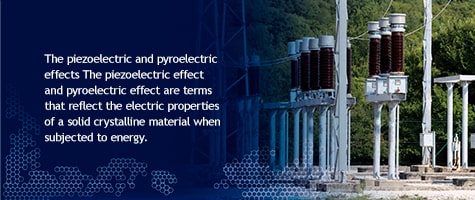Comparing the pyroelectric effect vs. the piezoelectric effect can help you understand how each one works and its ideal applications. The piezoelectric effect and pyroelectric effect are terms that describe a solid crystalline material’s electric properties when subjected to energy, but they are very different. These two effects differ in their displayed responses and the way their other properties change.
While the pyroelectric effect brings forth a voltage potential due to temperature changes, the piezoelectric effect produces energy from an externally-applied force. Although scientists discovered pyroelectricity first, pyroelectric materials are a subclass of piezoelectric materials. Each type of energy-producing material has unique capabilities and benefits different industries.
Scientists discovered the piezoelectric effect thanks to working with pyroelectricity. Experimenting with, observing and studying the pyroelectric effect led Pierre and Jacques Curie to discover the piezoelectric effect in 1880, and it has helped advance several types of devices and industries since. Pierre and Jacques completed experiments and measured the charge that squeezing a quartz slab induces to learn, which led to them to their piezoelectric discovery.
A pyroelectric effect occurs when a temperature change causes a crystal to change shape. This small deformation in the crystalline structure causes pyroelectric materials to generate charges when that deformation occurs. Measuring the voltage potential across the material allows you to see a pyroelectric effect.
Piezoelectricity is the creation of an electric potential within a crystalline substance resulting from mechanical stress.
The main difference between pyroelectricity and piezoelectricity is that a pyroelectric effect primarily occurs due to heat stress, and a piezoelectric effect occurs due to mechanical stress. While pyroelectric energy is defined as the creation of a voltage potential due to thermal changes, piezoelectric energy is due to externally-applied forces. The piezoelectric effect generates a surface charge on a material in response to an applied external force.
Piezoelectricity occurs in noncentrosymmetric materials, and pyroelectricity occurs in materials within a polar crystal symmetry class. The piezoelectric effect can occur in materials such as ceramics, organic substances and single crystals. The pyroelectric effect can occur in materials such as tendons, bones, gallium nitride and semiconductor materials.


The piezoelectric and pyroelectric effects The piezoelectric effect and pyroelectric effect are terms that reflect the electric properties of a solid crystalline material when subjected to energy. Piezoelectric and pyroelectric materials are similar to each other because they are non-centrosymmetric, which means they have a broken symmetry.
Piezoelectric and pyroelectric effects are also similar because of their energy capabilities. All pyroelectric crystals can produce pyroelectric and piezoelectric potentials, making them a subclass of piezoelectric materials. For example, materials such as ammonium, phosphate and quartz are pyroelectric and piezoelectric. However, not all piezoelectric materials can produce pyroelectric voltages.
The piezoelectric and pyroelectric effects also differ in their applications. Consider the following ways different industries can utilize these effects:
The piezoelectric effect has significantly impacted technology. This effect can be used in a variety of sensors, from sensing the vibration in a guitar string to lighting a grill. Whenever it’s necessary to create a spark at the push of a button, the piezoelectric effect can be applied.
Piezoelectricity principles apply to devices and industries such as:
The pyroelectric effect is common in applications such as power generation and heat sensors. Pyroelectric materials can reliably detect temperature changes, and they are incredibly beneficial in the following applications:
Piezoelectric materials and components offer the following benefits:
The main benefit of pyroelectric materials is that they are a cost-effective solution for sensor applications and electrical appliances. They are also pollutant-free, and they have a high-frequency response. Similar to piezoelectrical energy, pyroelectrical energy is also highly reliable. Pyroelectric materials are ideal for implantable and wearable electronic devices because they are endurable, small and flexible components.
Since piezoelectric materials are flexible, they can form several different types of components. Consider a few examples of the many piezoelectric ceramics and devices you can use in your equipment and products:
The piezoelectric and pyroelectric effects help advance technology in incredible ways. Piezoelectric and pyroelectric materials are important in various industries and applications because they increase device capabilities, reliability and flexibility.
APC International offers high-quality piezo products and services to help you improve your devices, equipment and products. We value our working relationships, and we are dedicated to meeting each customer’s precise needs with custom solutions. We offer in-house assembly to help your company save time and expenses, and our skilled engineers design high-quality devices for optimal performance.
When you work with APC International, you can trust us to design devices that meet your application’s unique specifications. Our experienced team can answer your questions about piezoelectric materials and capabilities. Contact us to learn more about our products and services.